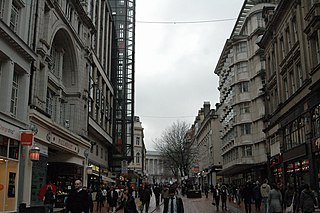
New Street is a street in central Birmingham, England. It is one of the city's principal thoroughfares and shopping streets linking Victoria Square to the Bullring Shopping Centre. It gives its name to New Street railway station, although the station has never had direct access to New Street except via Stephenson Place and latterly Grand Central shopping centre.

Although Birmingham in England has existed as a settlement for over a thousand years, today's city is overwhelmingly a product of the 18th, 19th, and 20th centuries, with little surviving from its early history. As it has expanded, it has acquired a variety of architectural styles. Buildings of most modern architectural styles in the United Kingdom are located in Birmingham. In recent years, Birmingham was one of the first cities to exhibit the blobitecture style with the construction of the Selfridges store at the Bullring Shopping Centre.
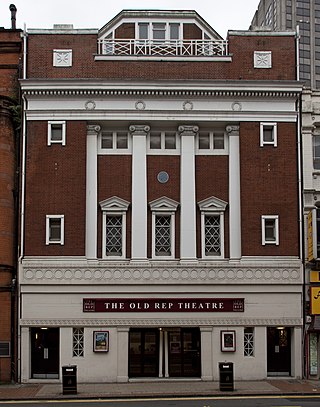
The Old Rep is a Grade II listed theatre, located on Station Street in Birmingham, England. When it was constructed in 1913, it was the United Kingdom's first ever purpose-built repertory theatre. When built, it became the permanent home for Barry Jackson's newly formed Birmingham Repertory Company, which began life in 1911, born from his amateur theatre group, The Pilgrim Players, founded in 1907. Jackson funded the construction of the theatre and established a professional, resident company there, which soon became a major powerhouse within the British theatre due to its innovative stagings of the works of both Shakespeare and George Bernard Shaw, resulting in some considering it to be Birmingham’s answer to The Old Vic.

Sir Edward Guy Dawber, RA was an English architect working in the late Arts and Crafts style, whose work is particularly associated with the Cotswolds.
Edward Prioleau Warren was a British architect and archaeologist.

George Gordon Hoskins FRIBA, was an English architect responsible for the design of several public buildings in the North East of England. His works include many large and important buildings - mansions, banks, hotels, hospitals, libraries, and schools.

George E. Harney was a late 19th-century American architect based in New York City.

Starrett & van Vleck was an American architectural firm based in New York City which specialized in the design of department stores, primarily in the early 20th century. It was active from 1908 until at least the late 1950s.
Francis George Fielder Hooper (1859–1938) was an architect who worked mostly in London and Kent.
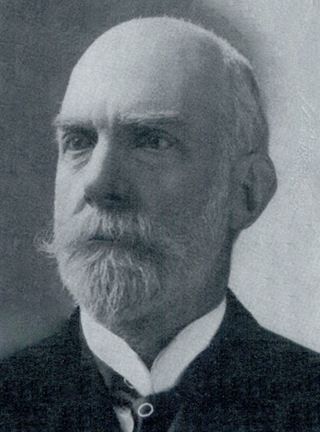
William Gibbons Preston was an American architect who practiced during the last third of the nineteenth century and in the first decade of the twentieth. Educated at Harvard University and the École des Beaux-Arts in Paris, he was active in Boston, New York, Rhode Island, Ohio, New Brunswick and Savannah, Georgia, where he was brought by George Johnson Baldwin to design the Chatham County courthouse. Preston stayed in Savannah for several years during which time designed the original Desoto Hotel, the Savannah Volunteer Guards Armory and 20 other distinguished public buildings and private homes. He began his professional career working for his father, the builder and architect Jonathan Preston (1801–1888), upon his return to the United States from the École in 1861, and was the sole practitioner in the office from the time his father retired c. 1875 until he took John Kahlmeyer as a partner in about 1885.
Thomas Lainson, FRIBA was a British architect. He is best known for his work in the East Sussex coastal towns of Brighton and Hove, where several of his eclectic range of residential, commercial and religious buildings have been awarded listed status by English Heritage. Working alone or in partnership with two sons as Lainson & Sons, he designed buildings in a wide range of styles, from Neo-Byzantine to High Victorian Gothic; his work is described as having a "solid style, typical of the time".
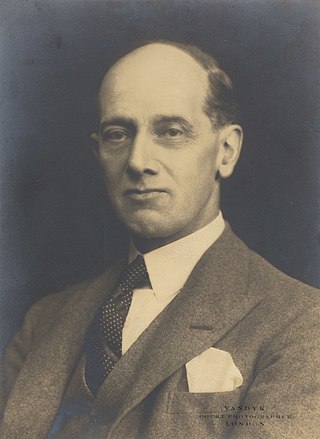
William Curtis Green was an English architect, designer and barrister who was based in London for much of his career. His works include the Dorchester Hotel, Wolseley House, New Scotland Yard, and the buildings, including the former Manor House, in Stockgrove Country Park. He was awarded the Royal Gold Medal in 1942. Around 20 of his designs are listed buildings. He was the younger brother of the craftsman and furniture designer Arthur Romney Green.

The Grand Hotel is a Grade II* listed Victorian five star hotel in the city centre of Birmingham, England. The hotel occupies the greater part of a block bounded by Colmore Row, Church Street, Barwick Street and Livery Street and overlooks St Philip's Cathedral and churchyard. Designed by architect Thomson Plevins, construction began in 1875 and the hotel opened in 1879. Extensions and extensive interior renovations were undertaken by prominent Birmingham architecture firm Martin & Chamberlain from 1890 to 1895. Interior renovations included the building of the Grosvenor Room with Louis XIV style decoration.
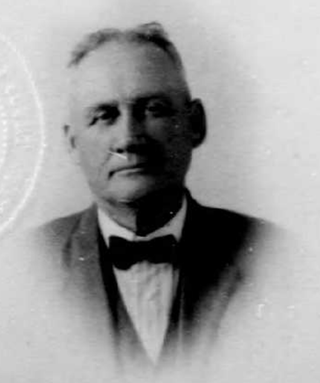
James Miller Creighton was an American architect who practiced in Phoenix, Arizona from the 1880s to the 1920s. He is considered to be one of Arizona's first architects.
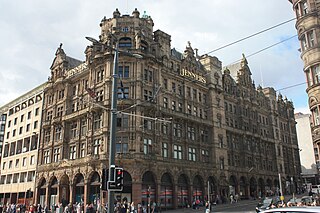
William Hamilton Beattie was a Scottish architect specialising in hotel design in the late 19th century.

John B. Sutcliffe was an English-born American architect.

William R. Walker was an American architect from Providence, Rhode Island, who was later the senior partner of William R. Walker & Son.

Henry Hill Vale was a British architect who was active in North West England in the late 19th century. He was born in Liverpool, Lancashire, into a Warwickshire family, and studied under the Liverpudlian architect Henry Roberts.
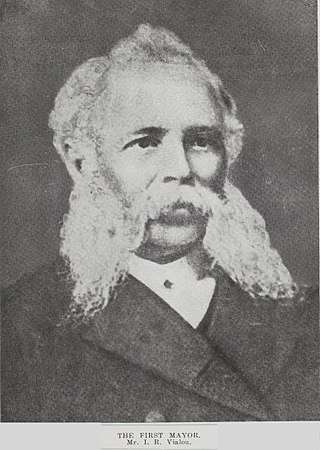
Isaac Richardson Vialou was a builder, architect and the first Mayor of Hamilton, New Zealand. He was born in England and emigrated to New Zealand in 1858.
George Campbell Sherrin FRIBA was a British architect. As a consultant architect for the Metropolitan Railway, Sherrin designed many railway buildings, including Moorgate station, and arcades at Liverpool Street station and High Street Kensington tube station. Some of his other notable works include the Old Spitalfields Market and the Kursaal.

















